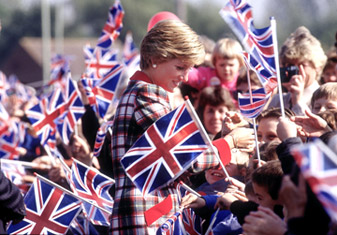
(3 of 4)
After her separation and divorce, Diana's efforts to redefine herself took on an edge of urgency. She had given up her patronage of most of the charities she once represented. She fantasized about becoming the wife of one of her boyfriends, a heart surgeon called Hasnat Khan, and living in anonymity. Yet she could never hope to become normal. Instead she became a celebrity. Then came Dodi Fayed.
Though friends say he was just a distraction, her choice of two Muslim boyfriends looked set to test how deep the tolerance of New Labour's Britain would go. This much is plain: she had long since escaped or shed the attitudes of many white Britons. After her death, Trevor Phillips, a black Labour politician who now chairs Britain's Commission for Equality and Human Rights, told Newsweek Diana "embraced the modern, multicultural, multi-ethnic Britain without reservation." Unlike most Europeans, she had "no flinch, no anxiety about race ... for nonwhite Britons, she was like a beacon in the darkness."
Wayne Sleep, a ballet dancer and media personality, got to know Diana well and remembers her "poking fun at aristocracy." In her final years, she mingled less and less with her own class, preferring instead the company of the self-made aristocracy of entertainment and fashion. The members of this élite were from different countries and cultures — gay, straight, black, white and united by fame. In Blair's Britain, they could expect invitations to 10 Downing Street, not always because of their talent. (Britain may have shrugged off its forelock-tugging subservience to the ruling classes, but in Cool Britannia money and celebrity counted.) Diana fitted into this new world perfectly. She wasn't seen as posh. She was one of the people. By example, she reassured them that anyone could be a star. All you needed, she seemed to imply, was the chance to display yourself to the world. After all, she'd done that more than once herself. In 1985, at a gala evening to celebrate Charles' 37th birthday, she left the royal box and appeared on stage, shimmying with Sleep. Charles was appalled. Diana's scheme to please him may have come undone, but she had helped Britain to unbutton.
From Fairy Tale to PostFeminist
Imagine this: Diana is still alive. She's a well-preserved 46, with a new boyfriend and an apartment in Manhattan. Is she popular? Maybe. A legend? No way. By dying young, Diana ensured her immortality. Better dead than wrinkled.
Celebrity culture is cruel, but especially to women. "One of the characteristics of celebrity culture is that you first build someone up and then you write about their downfall," says German writer Tom Levine, the author of a book on Britain's first family. "If Diana had lived she would have been going on that up-and-down train." Her last summer was already something of a downward ride. A slight weight gain set the press speculating she might be pregnant. She wasn't, and such close attention could not have been easy for a bulimic. But her public admission of her eating disorder in a 1995 interview with Martin Bashir for the BBC had encouraged hidden sufferers to seek help. Her life reflected many of the concerns of ordinary women — their weight, their relationship troubles — and by talking openly she also eroded the stigma attached to failure. Even a Princess battled the bulge, even a beauty lost her husband. Diana was criticized for her "American style of emotionalism," says feminist writer Naomi Wolf, but her approach actually represented a liberation theology in hidebound Britain. "It was very radical. She didn't just talk the talk, she walked the walk."
That was not the fate feminists predicted when the news of her engagement to Charles broke. The feminist magazine Spare Rib ran an article headed "DON'T DO IT DI". This slogan, rendered as a lapel button, became a fashionable accessory for the thinking woman. "On 29 July 1981," wrote the British journalist Beatrix Campbell of the fairy-tale wedding in St. Paul's Cathedral, "the deceitful and depressed engagement ended when this thin, wan, whiter-than-white woman walked down the aisle, propping up the aged patriarch who had got her into all this ... Her ivory silk wedding dress was a shroud."
By the time Diana died, however, many feminists had read her struggle against a sclerotic system as a parable of empowerment. Paglia dubbed her an "incredible superstar." That she was, but she would never have located herself in the feminist firmament. She wasn't interested in gender equality. She fought against a patriarchy because it was old-fashioned and restrictive, not because she repudiated its male values. The Princess was one of the first and most potent symbols of the "girl power" celebrated by the Spice Girls with their mildly predatory allure and celebration of girly friendship. It was a neat fit for Diana, with her close women friends and her troubled search for a mate. What Royal Spice really, really wanted was not at all radical: to love and be loved.
